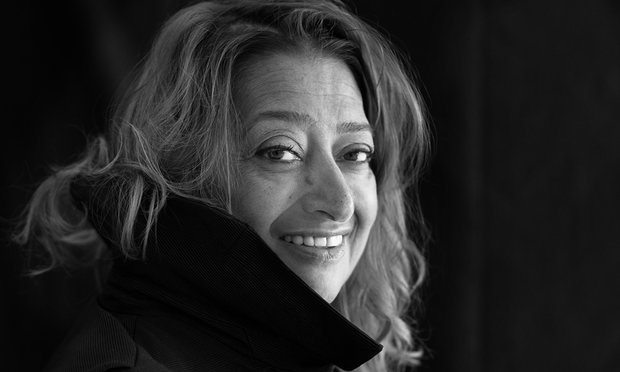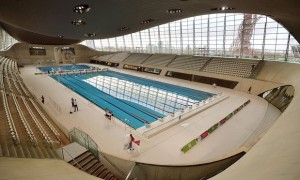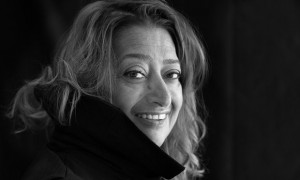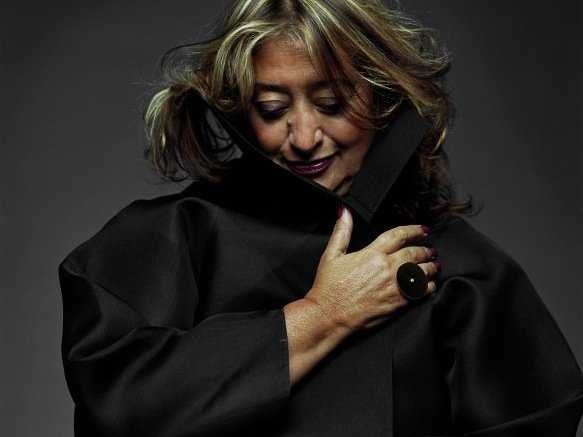Enterprenuer
DAME ZAHA HADID OBITUARY

Architect who first imagined, then proved, that space could work in radical new ways
In the London of the early 1980s, when Zaha Hadid, who has died aged 65 after a heart attack, first opened her own office in a small room in a redundant Victorian school in Clerkenwell, the idea that she might one day become one of the world’s most celebrated and successful architects would have seemed far-fetched. At a time when most architects were still under the lash of the Prince of Wales, camouflaging their work with a constipated brick and tile skin, or decorating their facades with fragments of postmodern confectionery, Hadid was not building anything. She was working night after night, essentially living in the drawings that flowed from her pen in an apparently unstoppable flood. They conjured up glimpses of a world she had imagined but which did not, as yet, exist. For those who didn’t get it, her work was seen as just too difficult. And she wasn’t going to try to ingratiate herself with those who did not understand her.
The most visible results of that period are a series of huge paintings that hinted at what she might build if she had the chance. They did not depict anything that could be conventionally identified as a building, but instead showed jagged landscapes in which walls and roofs, inside and outside, ground plan and cross section, merged seamlessly one into another. They were more like Piranesi dreamscapes than rational proposals for orthogonal buildings. But these were not abstractions or fantasies: they were the product of Hadid’s exploration of new ways to imagine how space might work, inspired in part by the drawings of the Russian artist Kazimir Malevich, whom she discovered when she was still a student.
The most famous of them were made for the competition she won in 1983 to design a resort complex in Hong Kong, known as The Peak. A series of overlapping cantilevers jutted out into space, providing layers of accommodation, bars and restaurants, as well as hotel rooms. The eminent engineer Peter Rice, who had worked on the Pompidou Centre in Paris, endorsed them as entirely buildable, but the client turned out not to have the cash. It was a failure to launch that is common in most architectural careers, where unbuilt schemes outnumber built projects by a large margin. But in Hadid’s case it was the start of what became a persistent theme for her critics. Hong Kong was not built; neither, 10 years later, was the Cardiff Bay Opera House. Most recently, her competition-winning design for Tokyo’s Olympic stadium was scrapped. She was blamed for all these, unfairly attacked for her personality as well as her competence.
The ideas that she was working through in the 1980s were most convincingly realised in the Heydar Aliyev centre, the cultural complex that she built in Baku, Azerbaijan, 30 years later. It resembles a gravity-defying snow-white iceberg that erupts from the ground like a twisting rollercoaster. And unlike some of her projects in which corners have been cut by builders in a hurry, Baku was beautifully finished, inside and out. Her critics saw this building as the glorification of a repressive and sinisterly authoritarian regime. For Hadid, it was the product of the negotiation with power that has always been part of the practice of architecture.
Hadid belonged to the last generation of architects to work with tracing paper and T-squares. She talked about the care with which she would use a Rotring pen and a ruler to draw. The trick, she said, was to ensure that there was no overlap when she joined two lines to make a sharp point at the corner of a rectangle. Despite these beginnings, she built a modern architectural office equipped with ranks of computers, and sophisticated parametric modelling software, in which rows of assistants sit working at screens plugged into headphones.
She was able to navigate a huge jump in the scale of her office. When she started out, a large architectural practice was 25 people. With her architectural partner Patrik Schumacher, she built a practice of 400. She took over the entire school building in which she had started, spread into a second building, and had plans to set up in the US. It is an operation that will certainly continue to make a mark: as Schumacher once said, the only way to be relevant against a background in which architecture is being defined by ever larger buildings is for an architectural practice to grow.
Skyscrapers and airports do not get built by lone geniuses; they require depths of complex administrative and professional expertise. Hadid was able to create one of the world’s most important architectural practices, one that, at the time of her death, was working in China, the Middle East, America and Russia. She built an extraordinary range of buildings: the Olympic Aquatics Centre in London, the Maxxi art museum in Rome (the RIBA Stirling prize winner in 2010), a car factory for BMW in Leipzig, Germany, a skyscraper complex in Beijing, an opera house in Guangzhou, an exhibition centre in the middle of Seoul. She was asked to work on projects from Libya to Saudi Arabia, and even on the Central Bank of Iraq.
She was able to make architecture that, though it had its roots in what was once called the avant garde, was genuinely popular. When the Design Museum in London gave Hadid her first British retrospective in 2007, it was the most successful architecture show the museum had ever staged. She went with remarkable speed from being regarded as unbuildably radical to the mainstream. In 2004 she became the first woman to win the Pritzker prize for architecture and this year the first to be awarded the RIBA royal gold medal in her own right. She was appointed CBE in 2002, and in 2012 she was made a dame.
Daughter of Mohammad Hadid and Wajiha al-Sabunji, she was born in Baghdad. Her father was a liberal politician who sent Zaha to a convent school despite being a Muslim. One of her brothers, Foulath, became an Oxford academic – Zaha later built a library for his college, St Antony’s. She grew up in a secular, modernising Baghdad at a time when Le Corbusier had been commissioned to build a sports complex, Frank Lloyd Wright was working on a cultural centre, and Walter Gropius had built a university campus. These were projects that she acknowleged might have inspired her choice of career, and certainly gave her a sense of the transformative power of architecture.
Later she went to an English boarding school, gained a maths degree at the American University of Beirut, and then, most importantly, studied at the Architectural Association school in London. The AA had become a hothouse, a licensed opposition in which dissidents and dreamers created an architecture, mainly on paper, that had nothing to do with the bleak architectural climate of the time.
The school in those days was led by Alvin Boyarsky, whom Hadid always cited as one of her most important influences. Her two most important teachers, apparently at the opposite ends of the architectural spectrum, were Leon Krier, who went on to become a close adviser to the Prince of Wales, and Rem Koolhaas, who uses the world brutal as a compliment. For many years, both Krier and Koolhaas presented building as a kind of sell-out. Hadid matched their reluctance to compromise but was always determined to build.
Hadid was given her first chance to make architecture on her own terms by Rolf Fehlbaum, owner of the Vitra furniture company. She designed a small building in Weil am Rhein, on the German border with Switzerland, to house the fire engine for the company’s volunteer fire brigade. It was a dynamic composition based on seemingly razor-sharp shards of concrete. When the fire brigade disbanded, the building was converted for a new role as part of the company’s museum. But the changes gave rise to an entirely inaccurate story that its shape had made it impractical.
As time went on, her buildings became less characterised by sharp lines, and turned more fluid, often taking forms that looked like spilt mercury. The change was in part a reflection of the transformation of the building industry made possible by new digital modelling programmes and new technologies. The engineers she worked with on such projects as the Phaeno Science centre, in Wolfsburg, Germany, were doing things with steel that would have been impossible a generation earlier. She was ready to explore the design of the smallest of objects, from cutlery to wine bottles, to the largest urban masterplans.
Her breakthrough project in Britain should have been the Cardiff Bay Opera House, a commission that she won against 400 entrants in an international competition in 1994. She proposed a design that ingeniously managed to be appropriately monumental for a national institution, but at the same time provided an injection of urbanity to what at the time was an empty wasteland. It was torpedoed by the Millennium Commission which, when invited to fund it, hilariously declared it to be insufficiently distinctive. Years later, it was replaced by an unmemorable design that had little to recommend it – except that it was not by Hadid.
Hadid was caricatured by those who did not know her as difficult, and too ready to build for despotic regimes. The most bizarre claim was made by Martin Filler in the New York Review of Books in 2014. He suggested that many workers had died on the site of one of her projects for a stadium in Qatar. It was an accusation that both magazine and writer were forced to retract when it was pointed out that work had not yet started. Nevertheless the claim was repeated by an inadequately briefed BBC interviewer. In what was presented as an interview to celebrate her nomination for the royal gold medal for architecture, an honour that involved having her name carved in the walls of the RIBA, she was asked about the deaths. Hadid rebutted the claim, and lost her composure only when asked why it was that people thought she was difficult.
Hadid was not afraid to show her feelings. When she did not like what an employee, or even a client, had done, she did not hold back from telling them what she thought. But when she liked someone, she was an unconditional, warm and loyal friend, with a sharp wit. Dinner with Hadid was like a session with Dorothy Parker at the round table. She was an accomplished mimic, with an interest in gossip. Those who left the table too early ran the risk that they would become the subject of the conversation.
She was fascinated by fashion, and had a spectacular dress sense, quickly graduating from Issey Miyake to Miuccia Prada. She celebrated her birthdays in style. One year, she laid on a display of synchronised swimming – a skill in which she suggested she had once been proficient – in the Olympic pool that she had designed. Another year, she produced belly dancers, and a dining table running from one end of the Burlington Arcade to the other.
Hadid’s architectural output reflected the shifting global landscape, which at the close of the 20th century was moving beyond northwest Europe and America, where modern architecture began. She was one of the first to build on a large scale in China, where she completed two extraordinary complexes in Beijing, involving a mix of high-rises and lower blocks.
She would, however, certainly have liked to build more in Britain. Her Olympic Aquatics Centre, now shorn of the unsightly banks of spectator seating grafted on for the duration of the Games, has been transformed into a bustling and successful neighbourhood swimming pool. There is the Maggie’s Centre on the edge of Kirkcaldy, the Glasgow Riverside Museum of Transport on the banks of the Clyde, a school in south London (the Evelyn Grace academy, Brixton, which won the Stirling prize in 2011), and a restaurant and exhibition space for the Serpentine Gallery, London.
Throughout her career, she was a dedicated teacher, enthused by the energy of the young. She was not keen to be characterised as a woman architect, or an Arab architect. She was simply an architect.
She is survived by a brother, Haytham.
• Zaha Hadid, architect, born 31 October 1950; died 31 March 2016
CULLED FROM: http://www.theguardian.com/artanddesign/2016/apr/01/zaha-hadid-obituary?CMP=share_btn_fb








